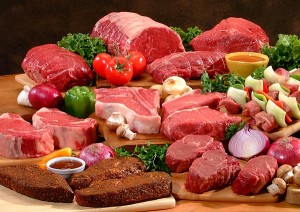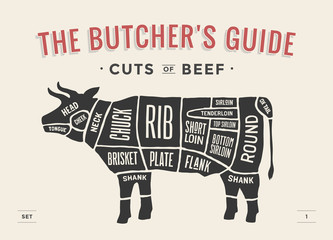How to Choose Meat

Choosing the Right Cut and Grade of Meat
We’ve all been there; in the grocery store, at the meat counter. There are all different types of steaks and cuts of meat. If you’re making stew, what should you buy? If you’re planning on grilling, and you want a tender juicy steak, which cut is best?
Before I begin, let’s talk about an important term, marbling. Marbling is the small streaks of fat found within the muscle and can be seen in the cut of meat. Marbling has a strong beneficial effect on juiciness and flavor, and may also have a positive effect on tenderness. Meat that has little marbling may be dry and flavorless. Excessive amounts of marbling will not necessarily increase the juiciness and flavor over those cuts of meat with modest marbling. When picking your meat, choose a piece with average marbling. The streaks of fat should make up approximately 1/3 of the meat in ratio.
A quality grade is a composite evaluation of factors that affect palatability of meat (tenderness, juiciness, and flavor). These factors include carcass maturity, firmness, texture, and color of lean, and the amount and distribution of marbling within the lean. Beef carcass quality grading is based on (1) degree of marbling and (2) degree of maturity. In order, the three beef quality grades are Prime, Choice, and Select.
Choosing the Right Cut of Meat
There are many different cuts of meat. If you want a soft, succulent piece of meat try Filet Mignon, a Delmonico cut, Porterhouse, T-Bone, or New York Strip Steak. If you’re making a stew or roast look for some lean Chuck. If Fajitas are on your menu, marinate and grill some London Broil; make sure to slice it thin!
These are just a few suggestions. Speak to your butcher; they’re usually very knowledgeable and willing to help.

Cuts of Beef
Chef Chuck Kerber






 in <b>/var/www/vhosts/cooksandeats.com/httpdocs/wp-content/themes/CooksandEats/sidebar.php</b> on line <b>1</b><br />
/wp-content/themes/CooksandEats/images/side-logo.png)



 in <b>/var/www/vhosts/cooksandeats.com/httpdocs/wp-content/themes/CooksandEats/footer.php</b> on line <b>13</b><br />
/wp-content/themes/CooksandEats/images/back-to-top.png)
Thank you Chef Chuck for How To Choose Meat. Sometimes I do have a hard time choosing meat. When there is not a butcher around to ask advice about what of meat to pick.